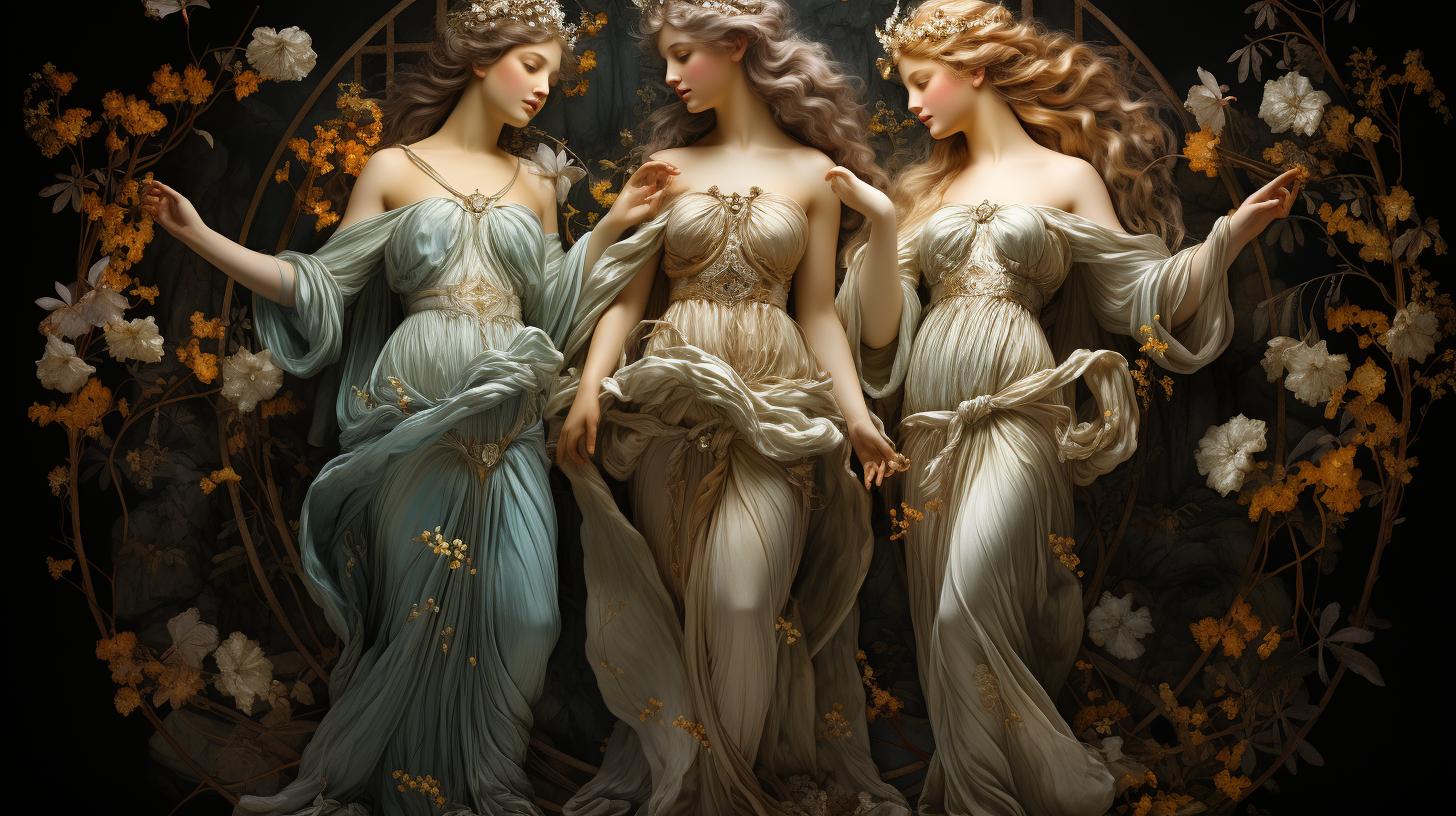Who Was Medusa in Greek Mythology: Unraveling the Mythical Tale in Ancient Greece

Medusa in Greek mythology is a legendary figure known as one of the Gorgons. Described as a female creature with snake hair, Medusa had the power to turn people to stone with her gaze.
She was the only mortal Gorgon, and Perseus decapitated her, using her head as a weapon and a protective amulet. Medusa’s image appears in various forms in ancient art, recognizable by her distinctive frontal position and features.
This article explores Medusa’s origins, her encounters with heroes like Perseus and Heracles, her symbolism, and her impact on literature, art, and popular culture.
The Origins of Medusa in Greek Mythology
In Greek mythology, the story of Medusa begins with the Gorgon Sisters.
This mythical trio consisted of three sisters: Medusa, Stheno, and Euryale. They were monstrous creatures with snakes for hair and the ability to turn anyone who looked at them into stone.
Medusa, in particular, emerged as the most famous and notorious of the three.
The Gorgon Sisters: Meet the Mythical Trio
The Gorgon Sisters, often depicted as fearsome and formidable, were known for their unique appearance and petrifying gaze. Medusa, however, had a distinct role among her sisters. Unlike Stheno and Euryale, Medusa was not immortal.
This vulnerability played a crucial part in her eventual encounter with the hero Perseus.
Medusa’s Physical Description: A Snake-Haired Creature
Medusa’s physical characteristics set her apart from other mythical creatures. Her most distinctive feature was her hair, composed of writhing serpents that hissed and slithered. This unique trait became a symbol of her terrifying power.
Her countenance was often described as fearsome, with bulging eyes and a menacing expression.
Medusa and Poseidon: The Union and Its Consequences
According to the myth, Medusa’s fate intertwined with the sea god Poseidon. It is said that Poseidon, overcome with desire, took advantage of Medusa’s beauty. As a result of their union, two children were born: the winged horse Pegasus and the warrior Chrysaor.
However, this encounter had dire consequences for Medusa.
With her monstrous transformation and her union resulting in the birth of powerful offspring, Medusa’s origins in Greek mythology offer a complex web of relationships and consequences.
These elements set the stage for the legendary tales and encounters that would follow.
The Legendary Hero: Perseus and Medusa’s Demise
The story of Medusa’s demise is closely intertwined with the heroic deeds of Perseus, who embarked on a challenging quest to slay the Gorgon. Let us delve into the details of this legendary hero’s journey and his fateful encounter with Medusa.
Perseus Receives a Challenging Quest
In his quest to avenge the wrongdoings inflicted upon his family, Perseus receives a formidable task from King Polydectes: to bring him the head of the dreaded Medusa. Thus, armed with divine weapons and accompanied by helpful beings like Hermes and Athena, Perseus sets out on his dangerous mission.
Perseus’ Confrontation with Medusa
Guided by Athena’s wisdom and equipped with a polished shield that served as a mirror, Perseus cautiously approaches the lair of the Gorgons. With steadfast determination, he manages to avoid Medusa’s deadly gaze by using his mirrored shield as a reflection.
In a swift and decisive strike, Perseus strikes a blow, severing Medusa’s head from her shoulders.
The Gorgon’s Head as a Weapon and Symbol
The decapitated head of Medusa holds great significance in its own right. Not only is it a potent weapon against foes, turning them to stone, but it also becomes a powerful symbol of protection.
Perseus utilizes the Gorgon’s head strategically, using its petrifying powers to thwart his enemies and safeguard those in need.
Perseus’ heroic tale serves as a testament to the valor and resourcefulness required to confront the perilous Medusa.
The image of Perseus facing his nemesis has captured the imagination of artists and storytellers throughout history.
Medusa’s Legacy: Myths, Art, and Symbolism
Medusa’s story extends beyond Greek mythology, leaving a significant mark on various aspects of culture, including art, symbolism, and even beliefs. Her enduring legacy continues to captivate artists and storytellers alike.
Medusa’s Role in Greek Mythology and Beyond
Medusa’s role in Greek mythology transcends her status as one of the Gorgons. She symbolizes the dangers of female power and serves as a cautionary tale about the consequences of hubris.
Her story resonates with themes of transformation, femininity, and the clash of mortal and divine.
Medusa’s Image in Ancient Greek Art and Sculpture
Medusa’s image has been immortalized in the art of ancient Greece. Depicted as a formidable creature with snake hair and a fierce gaze, she became a common motif in pottery, sculpture, and architectural design.
Her recognizable face, often shown in a frontal position, served as a symbol of protection and warding off evil forces.
The Power of Medusa’s Gaze in Ancient Beliefs
Medusa’s power resides in her gaze, capable of turning anyone who meets her eyes into stone. This ability fascinated the ancient Greeks, who believed in the supernatural potency of her petrifying stare.
Medusa’s gaze embodied the concept of a destructive and immobilizing force, serving as a warning against the allure and dangers of beauty.
Exploring Medusa in Literature and Popular Culture
Medusa, the iconic figure from Greek mythology, has left a lasting impression on various forms of artistic expression throughout history. Her presence can be found in ancient Greek epics, like the renowned works of Homer.
Medusa often appears as a powerful antagonist, representing the fearsome monstrosity that heroes must overcome.
Medusa’s Presence in Ancient Greek Epics
In ancient Greek literature, Medusa is prominently featured in epic poems such as Homer’s Odyssey and Iliad. She embodies a formidable obstacle for the heroes, adding thrilling elements to their quests.
Medusa’s deadly gaze and serpentine hair create an air of tension and danger, highlighting the heroic deeds required to defeat her.
Medusa’s Influence on Renaissance Art and Literature
The fascination with Medusa persisted throughout different periods, including the Renaissance. Artists and writers drew inspiration from her mythical allure, showcasing her in paintings, sculptures, and literary works. Medusa’s visage became a symbol of beauty and terror, embodying the dichotomy of attraction and danger.
Medusa in Modern Works: Books, Film, and Adaptations
Medusa’s allure continued to capture the imaginations of contemporary writers and filmmakers. She has been reimagined and portrayed in numerous works, exploring the complexity of her character and the underlying themes of transformation and power.
From novels to films, Medusa’s presence in modern popular culture showcases her enduring relevance.
Frequently Asked Questions about Medusa
Curious to learn more about Medusa in Greek mythology? Here are some frequently asked questions that shed light on her intriguing story:
Was Medusa a Beautiful Creature?
Contrary to popular belief, Medusa was not always depicted as a monstrous figure. While her sisters were always described as fearsome Gorgons, Medusa was sometimes portrayed as a beautiful woman. It wasn’t until she was cursed by Athena for desecrating her temple that her appearance transformed into that of a terrifying creature with venomous snakes for hair.
Can Medusa Turn Herself into Stone?
No, Medusa’s gaze had the power to turn others to stone, but she herself was immune to this petrifying effect. It was her unique ability, a result of Athena’s curse, to transform those who dared to look upon her into lifeless statues.
What Happened to Medusa’s Head after Perseus Killed Her?
After Perseus successfully decapitated Medusa, her head remained a potent weapon capable of turning enemies to stone. He presented the severed head to the goddess Athena, who incorporated it into her shield, known as the Aegis.
In some versions, Perseus buried Medusa’s head in the marketplace of Argos, ensuring its power continued to safeguard the city.
- Was Medusa a Beautiful Creature?
- Can Medusa Turn Herself into Stone?
- What Happened to Medusa’s Head after Perseus Killed Her?
Unraveling the Medusa Myth: Various Interpretations
Unraveling the Medusa myth presents us with intriguing insights into its different interpretations throughout Greek and Roman mythology.
It is fascinating to explore the diverse versions of Medusa’s story and how they have evolved over time. Let’s venture into the various aspects of her mythical tale and its connections to other gods and goddesses.
Different Versions of Medusa’s Story in Greek Mythology
Medusa’s story in Greek mythology has seen various retellings and interpretations. One version depicts her as a human priestess in the temple of Athena, who was transformed into a monster as a punishment for desecrating the goddess’s sacred space.
Another version portrays her as a beautiful maiden who was cursed by Athena out of jealousy. These varying accounts offer us a glimpse into the multifaceted nature of Medusa’s myth.
Medusa in Roman Mythology and Its Variations
In Roman mythology, Medusa’s story underwent transformations and adaptations. Here, she is known as ‘Medusa Gorgon,’ a monstrous creature with a terrifying gaze. The Roman poet Ovid describes her encounter with the hero Perseus in his epic poem Metamorphoses, providing a different perspective on her demise.
The Roman version of the Medusa myth adds an additional layer to her character and expands the reach of her legend.
Medusa’s Connection to Athena and Other Gods
One intriguing aspect of Medusa’s myth is her connection to the goddess Athena. In some accounts, it was Athena who cursed Medusa, turning her into a monster. However, in others, Medusa is seen as a victim of circumstance, caught in the rivalry between Athena and Poseidon. Medusa’s complex relationship with other gods and goddesses further enriches her narrative and highlights the intricate web of Greek mythology.
Medusa’s Significance in World History and Art
Medusa, the iconic figure of Greek mythology, holds immense historical and artistic significance. Her influence can be seen in various aspects, ranging from ancient Greek and Roman culture to the symbolism of female power and representations of transformation and protection.
Medusa’s Influence on Ancient Greek and Roman Culture
Medusa’s presence in ancient Greek and Roman culture was profound. She was often depicted in artwork, sculptures, and architectural designs, symbolizing both fear and fascination. Medusa’s image appeared in temples, including the famous ancient Greek Parthenon, and her story was frequently told through various forms of artistic expression.
Medusa and the Symbolism of Female Power
Medusa represents a complex symbol of female power in Greek mythology. As a Gorgon, she challenges traditional notions of femininity and carries a distinctive aura of strength, independence, and defiance.
Her snake-hair and ability to petrify reflect the power to intimidate and protect herself. Medusa’s significance as a symbol of female empowerment continues to inspire and provoke discussions on gender dynamics throughout history.
Medusa as a Representation of Transformation and Protection
Medusa’s story is intertwined with themes of transformation and protection. The severed head of Medusa symbolized a powerful weapon against enemies in Greek mythology. Furthermore, her image, known as Gorgoneion, was used as an amulet for protection against evil forces.
Medusa’s ability to shift from beauty to monstrous form embodies the transformative nature of life, while the Gorgoneion acts as a shield against adversity.
Medusa and the Odyssey: Exploring Her Role
Medusa’s Mention in Homer’s Epic
In Homer’s epic poem, “The Odyssey,” Medusa is mentioned as one of the many dangers that the hero, Odysseus, encounters during his long journey back home after the Trojan War.
Although her appearance is brief, her mention highlights the perilous nature of Odysseus’ quest and the formidable adversaries he must face along the way.
Medusa’s Impact on Odysseus’ Journey
Medusa’s presence in “The Odyssey” serves as a reminder of the supernatural and monstrous challenges that Odysseus must overcome. Her image showcases the dangerous and treacherous elements of the mythical world that the hero traverses.
The Medusa Myth in The Odyssey: Themes and Symbolism
The myth of Medusa in “The Odyssey” carries several key themes and symbolisms. One prominent theme is the concept of transformation, as Medusa’s serpentine appearance reflects the monstrous consequences of divine punishment.
Additionally, her ability to petrify with her gaze symbolizes the paralyzing and overwhelming nature of fear. The encounter with Medusa also underscores the importance of resourcefulness and strategy in dealing with perilous situations.
In summary, Medusa’s role in “The Odyssey” is a brief yet significant part of Odysseus’ challenging journey. Her mention emphasizes the dangerous nature of his quest, while also exploring themes of transformation, fear, and the importance of strategy.
This encounter with Medusa adds depth and complexity to the overall narrative of Odysseus’ adventures.
Medusa in Greek Art: Aesthetics and Depictions
Medusa’s captivating image has been a prominent subject in ancient Greek art, showcasing the evolution of her portrayal and the influence she held over artists. Let’s delve into the aesthetics and depictions that Medusa inspired within Greek artistic expressions.
The Evolution of Medusa’s Image in Ancient Greek Art
In the realm of ancient Greek art, Medusa’s image experienced a fascinating evolution. Early depictions focused on her monstrous, frightening features, emphasizing her snake-hair and petrifying gaze. As time progressed, Medusa’s portrayal shifted, and she began to exhibit more human-like qualities.
Artists skilfully conveyed Medusa’s contrasting beauty and terror, blending feminine attributes with serpentine elements. This evolution illustrates the nuanced perception of Medusa, from a purely monstrous creature to a complex and captivating figure.
Medusa’s Representation in Pottery and Sculpture
Pottery and sculpture played crucial roles in immortalizing Medusa’s image in ancient Greek art. On pottery, she frequently appeared as a decorative motif, bringing elements of intrigue and symbolism into various vessels and utensils.
In sculpture, Medusa’s unruly snakes intertwining with her hair became a recurring artistic motif. Sculptors skillfully captured her intense expression and captivating presence, often portraying her as a standalone subject or as an intricate part of decorative elements in larger artworks.
Medusa’s Presence in Temples and Architectural Design
Medusa’s influence extended beyond the realm of pottery and sculpture to the realm of architecture. Her countenance adorned temples and other architectural structures, standing as a powerful guardian against evil forces.
Her visage, known as the Gorgoneion, served as a protective amulet, effectively warding off malevolent energies. The Gorgoneion’s depiction remained consistent, showcasing Medusa’s recognizable features, such as her fierce expression and serpentine hair.
Medusa’s presence in Greek art not only showcased the artists’ skills but also emphasized the enduring fascination with her captivating allure and potent symbolism. The transition from a terrifying monster to a multifaceted figure reveals the depth of the Greek artistic imagination and the ongoing exploration of Medusa’s significance in Greek culture.
The Complex Legacy of Medusa in Greek Mythology
Medusa, the infamous Gorgon, has a multifaceted legacy within Greek mythology, capturing both fear and intrigue. Her story transcends the boundaries of ancient Greece, leaving a lasting impression on art, literature, and popular culture.
Medusa’s Role as a Symbol of Female Monstrosity
Medusa’s monstrous appearance, with her snake-hair and ability to turn people to stone, has often been interpreted as a representation of female monstrosity. In ancient Greece, Medusa’s terrifying visage served as a cautionary symbol against the power and danger of women, reinforcing societal fears and control.
Her image as a grotesque creature embodies the ancient Greek belief in the binary of beauty and ugliness, where Medusa represents the dark side of femininity – the antithesis of the idealized, beautiful female figures.
Medusa as a Representation of Female Resilience
Contrary to her depiction as a monster, Medusa’s story can also be seen as a tale of female resilience. Despite her transformation, Medusa’s myth highlights her ability to navigate through challenging circumstances.
In some retellings, Medusa’s encounter with Perseus and subsequent death is portrayed as an act of liberation from her curse. This interpretation positions her as a victim of circumstance rather than an inherently monstrous figure, showcasing her resilience and the potential for redemption.
The Enduring Fascination with Medusa and Her Story
Throughout history, Medusa’s captivating story has continued to fascinate and inspire various artistic works, from ancient Greek pottery to modern-day adaptations in books, films, and visual art.
The themes of transformation, power, and female agency present in Medusa’s myth resonate with contemporary audiences, prompting ongoing explorations and reinterpretations.
Her enduring legacy serves as a testament to the timeless allure and complexity of Greek mythology.




















